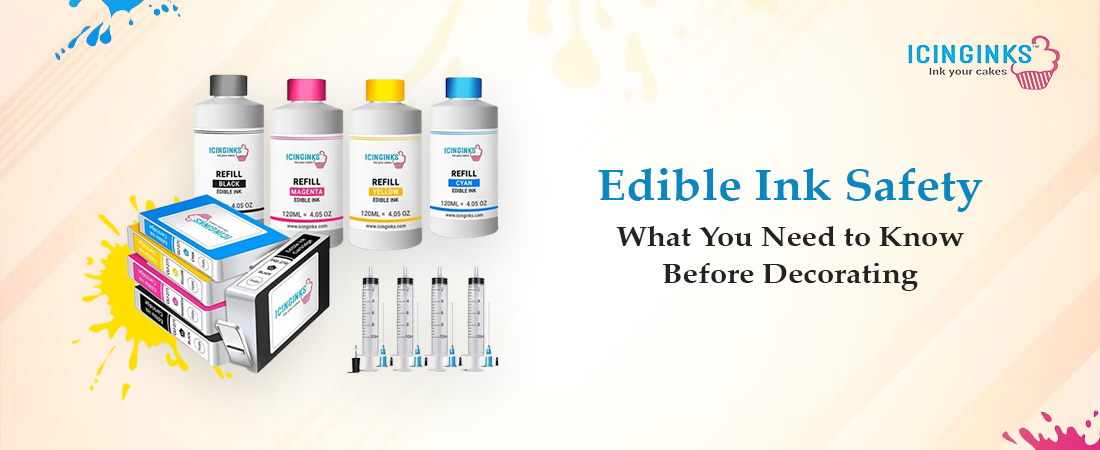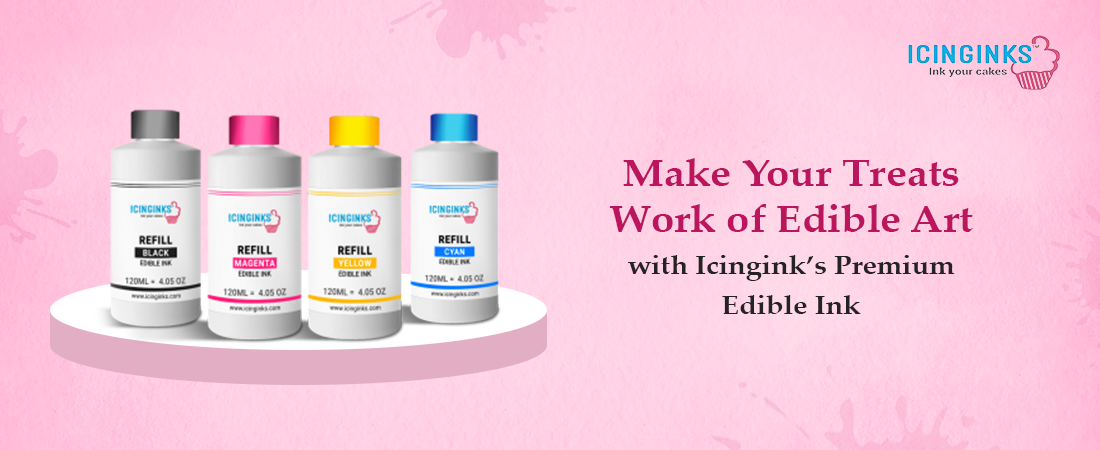
In recent years, cake decorating and edible printing have surged, allowing bakers and enthusiasts to transform edible creations into personalized masterpieces. One of the key components enabling this trend is edible ink, a specially formulated type of ink used in food printers. However, as with any food-related product, understanding the safety considerations surrounding edible ink is crucial before starting with edible decorations.
Understanding Edible Ink
Edible ink is a specialized type of ink manufactured specifically for food decoration. It is primarily used in edible printing, such as decorating cakes, cookies, and other confectionery items. Unlike regular ink containing non-edible components, edible ink comprises FDA-approved food coloring agents and other safe ingredients.
Key Components of Edible Ink
-
Food-Grade Coloring Agents
Derived from natural sources or synthetic compounds approved for consumption, these pigments undergo rigorous testing to meet safety standards set by regulatory bodies like the FDA.
-
Purified Water or Food-Grade Solvents
Acting as carriers for the coloring agents, they ensure the ink's viscosity and facilitate smooth printing.
-
Glycerin or Propylene Glycol
Essential for maintaining the ink's consistency and preventing rapid drying, these ingredients play a crucial role in the formulation.
Safeguarding Creativity: Vital Safety Measures When Using Edible Ink
Ensuring safety when using edible ink is fundamental in creative food decoration. Just as artists meticulously select tools to bring visions to life, understanding and implementing vital safety measures with edible ink are paramount. Here are some essential safety measures to follow when using edible ink.
-
FDA Approval Assurance
Prioritize edible inks endorsed by the FDA. This certification guarantees that the ink meets stringent safety benchmarks established for consumption. Look for products that prominently display this certification to ensure peace of mind.
-
Allergen Awareness
Scrutinize the ingredient labels for allergens. Some edible inks may contain elements that can trigger allergic reactions in susceptible individuals. A thorough check ensures the ink's ingredients align with dietary restrictions or allergens.
-
Proper Storage Protocols
Follow manufacturer guidelines meticulously regarding storage instructions. Edible ink's quality and safety can only be protected if stored correctly. Maintain optimal conditions to preserve its integrity and usability.
-
Mindful Printer Maintenance
Dedicate a specific printer for edible printing purposes. This prevents cross-contamination with regular inks that might contain non-edible components. Regularly clean and maintain the printer according to manufacturer specifications.
-
Reliable Suppliers and Quality Control
Source edible ink solely from reputable suppliers that adhere to the highest quality and safety standards. Trustworthy suppliers prioritize stringent quality control measures, ensuring the ink is safe for consumption.
-
Understanding Expiry Dates
Adhere strictly to expiration dates. Consuming expired edible ink can pose potential health risks. Replace cartridges before they expire to maintain the ink's safety and quality.
Mastering the Art of Safe Edible Ink Application: Best Practices
-
Preliminary Testing
Before applying the ink onto edible surfaces, conduct a test print on non-edible paper. This ensures smooth ink flow and helps detect any issues or contaminants before decorating food items.
-
Surface Preparation
Thoroughly clean and dry the surfaces intended for printing. Remove any grease, moisture, or residues affecting ink adherence, ensuring the ink applies flawlessly.
-
Careful Handling
Handle edible ink cartridges cautiously, avoiding direct contact with hands or surfaces that could compromise cleanliness. Ensure a clean environment to minimize potential contaminants.
-
Appropriate Ink Usage
Use edible ink cartridges intended for the specific printer model. Mixing or using incompatible inks might damage the printer and compromise safety.
-
Precision in Printing Techniques
Familiarize yourself with proper printing techniques recommended by the printer and ink manufacturers. Correct settings and application techniques ensure accurate and safe printing.
-
Dispose Responsibly
Dispose of used cartridges in compliance with local waste disposal regulations. Proper disposal prevents environmental contamination and ensures safety.
-
Quality Ingredients
Ensure the food items being decorated are fresh and of high quality. Combine safe edible ink with premium ingredients to guarantee a delightful culinary experience.
Elevate Your Edible Printing Experience with Icingink's Premium Edible Ink
Discover unparalleled creative possibilities in edible printing with Icinginks. Our commitment to excellence shines through in our meticulously crafted edible inks, surpassing the industry's highest safety and quality standards.
Crafted with precision and care, our edible inks are free from dairy, gluten, and nuts, ensuring compliance with FDA standards and passing stringent food safety tests.
Experience excellence in printing with our premium quality edible ink for Canon and Epson printers. We meticulously match our edible ink colors with regular inks, guaranteeing stunning, vivid results that bring your creations to life.
Our edible inks are formulated to prevent clogging, ensuring your printer operates smoothly even after prolonged periods of non-use.
Maintaining the integrity of your printer is paramount, and our edible inks are engineered with a gentle formulation that won't corrode or damage any metallic parts. Whether it's a Canon or Epson printer dedicated to edible printing, our inks promise optimal performance without compromising safety or quality.
At Icinginks, our priority is your safety and environmental responsibility. Our water-based formula eliminates toxicity and chemical hazards, making our edible inks safe for use on any cake, pastry, or cookie. You can trust that our inks pose no environmental pollution risks, ensuring a safe and healthy printing experience.
Level up your edible printing game with Icinginks' brilliance! Start creating your tasteful masterpieces with our premium edible inks. Elevate flavors and spark the imagination – Order now and let your treats become edible art!

FAQs
-
What is edible ink, and is it safe to consume?
Edible ink is specially formulated in food printers to print images like cakes, cookies, and chocolates on edible surfaces. It's designed with FDA-approved food coloring agents and other safe ingredients, making it safe for consumption.
-
Can I use regular printer ink instead of edible ink for printing on cakes?
No, regular printer ink should never be used for printing on edible surfaces. Edible ink is specifically manufactured to comply with food safety standards, ensuring it is non-toxic and safe for consumption. In contrast, regular printer ink contains non-edible components and should not be ingested.
-
What are the key considerations when choosing edible ink for printing on cakes?
When selecting edible ink, prioritize FDA-compliant options free from allergens like dairy, gluten, and nuts. Additionally, ensure the ink is compatible with your specific printer model and provides vibrant colors for the desired printing quality.
-
How long does edible ink last, and how should it be stored?
Edible ink typically has a shelf life of 6 to 12 months. Store it in a cool, dry place away from direct sunlight and extreme temperatures to extend its lifespan. Follow the manufacturer's guidelines for proper storage to maintain ink quality.
More interesting blogs to read on Icinginks
How to Use Edible Ink to Print Pictures on Cake or Food
How To Refill Edible Ink Cartridges
What is the Difference between Edible Food Colorings & Edible Inks?
Ultimate Guide to Use Edible Ink Pens and Markers




